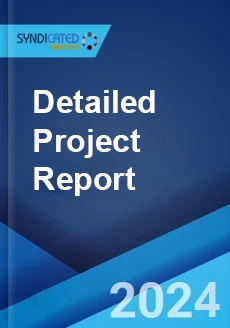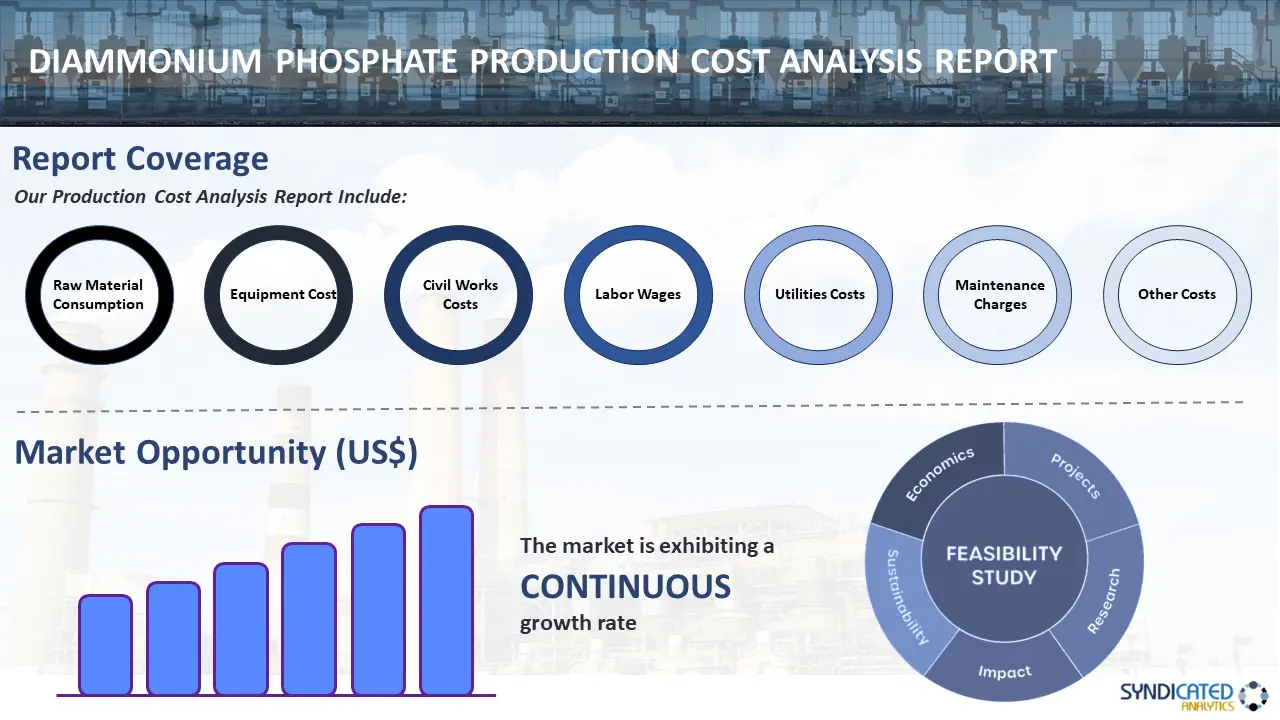
Diammonium Phosphate Production Cost Analysis Report 2025 Edition: Industry Trends, Capital Investment, Price Trends, Manufacturing Process, Raw Materials Requirement, Operating Cost, and Revenue Statistics
Report Overview
The report by Syndicated Analytics, titled “Diammonium Phosphate Production Cost Analysis Report 2025 Edition: Industry Trends, Capital Investment, Price Trend, Manufacturing Process, Raw Materials Requirement, Operating Cost, and Revenue Statistics,” presents an exhaustive analysis of both the operational expenses and revenue projections for setting up an diammonium phosphate manufacturing facility. Resulting from thorough primary and secondary research efforts, this document offers an in-depth exploration of market dynamics and the effects of the COVID-19 pandemic at both global and regional scales. The study meticulously examines price fluctuations, the balance of mass against required raw materials, and the critical unit operations essential to the diammonium phosphate production process. A detailed assessment of capital expenditures is provided, encompassing the breakdown of expenses related to raw materials, utilities, labor, packaging, transport, land acquisition, construction, and equipment. Additionally, the report forecasts profit margins and suggests strategies for setting optimal product prices. For those considering entering the diammonium phosphate market or current stakeholders, this report serves as a vital tool.

Diammonium Phosphate Market Overview:
The market for diammonium phosphate is experiencing steady growth, driven by the increasing agricultural demand. The contribution of DAP (di-ammonium phosphate) as a vital ingredient in fertilizers emphasizes the importance of the nutrient in farming. Its capability of wastewater recycling enriches the soil with natural nourishments, including phosphorus and nitrogen, which are quite valuable in increasing yields of crops and improving soil fertility. Along with the increasing population, the world is also witnessing elevated agro production which is expressly fueled by the demand for DAP fertilizers. Growing demand for commercial inputs in countries with many prosperous agricultural enterprises is particularly noteworthy, since their quest for effectiveness necessitates a substantial number of agricultural inputs. The food and agriculture organization (FAO) estimates that global food production will need to increase by about 70% to feed the growing population by 2050.
Agricultural inputs are getting embedded in environmentally sustainable practices. Phosphorus runoff is becoming an increasing issue which not only threatens the environment but also degrades the water quality, thus resulting in strong attention given to the management of phosphorus in agriculture. This increased regulatory oversight pushes the development of innovation in the sector which increases the ability to produce controlled release fertilizers and more precise application technologies in the end, this reduces environmental footprints when still supporting agricultural production. These innovations not only help minimize the risks attributable to the environment but also conform to the increasing trend among consumers and regulators alike in favor of the use of sustainable agricultural practices.
Diammonium Phosphate Market Trends:
Emerging Innovations in DAP
Continuing technological advancements in the creation of DAP is associated with better manufacturing processes that can facilitate reducing production costs and maintaining a sustainable environment. New production techniques can generate top-notch DAP with improved fertilizing profiles, which result in more effective and attractive to consumers products. Moreover, recent innovations in adjacent agricultural technologies, such as precision farm instruments provide a better system of farming which implies the attainment of the highest level of efficiency in utilizing the DAP.
The fertilizer association of India (FAI) reported that the global prices of diammonium phosphate (DAP) have increased to USD 595 per tonne from USD 440 per tonne in July of this year. Previously, in April 2022, DAP was priced at USD 924 per tonne.
Global Trade Dynamics
Global economic connections and trade policies play a pivotal role in shaping the recent course of cross-border DAP. Countries with major DAP producers extensively exercise their power over the entire process of the global supply, relying on policies, and tariffs to set the strategic position in the market. The introduction of new regulations by a major producing country can provoke supply bottlenecks and consequently supply and global prices fluctuations.
Political issues such as trade conflicts or agreements significantly change marketing patterns, therefore it is crucial for stakeholders to comprehend the geopolitical factors that could modify the trades flows and market access.
Latest Industry News:
- 11th May 2023: PhosAgro announced plans to launch the production of over 0.5 million tons of diammonium phosphate and about 1 million tons of NPK fertilizers by 2026.
- 23rd January 2023: OCP Group and India entered a strategic partnership to strengthen food security and confirmed their common ambition for an innovative and sustainable agriculture. The objective of this partnership is to carry out joint research & development initiatives, to jointly promote innovative fertilization solutions, and to offer tailor-made fertilizers that meet the specific needs of Indian farmers.
Market Analysis
This section delves into the dynamics of the diammonium phosphate market, including overview, historical and current performance, and impact of COVID-19. It examines factors driving demand, identifies key market trends, and analyzes the price trend. This analysis provides stakeholders with critical insights into market opportunities and challenges.
| Market Overview | Provides a broad introduction to the diammonium phosphate market, including its definition, applications, and the role it plays in various industries. |
| Historical and Current Market Performance | Examines the market's development over time, highlighting trends, growth patterns, and significant changes in the market landscape. |
| Impact of COVID-19 | Analyzes the effects of the global pandemic on the diammonium phosphate market, including disruptions in supply chains, changes in demand, and long-term implications. |
| Market Forecast | Projects the future trajectory of the market based on current data, trends, and potential future developments. |
| Market Breakup by Segment | Segments the market based on product types, applications, or other relevant criteria, providing detailed insights into each segment's performance and prospects. |
| Market Breakup by Region | Discusses the market's geographical distribution, analyzing key regions and countries in terms of market size, growth opportunities, and challenges. |
| Price Trend | diammonium phosphate Price Trend: Examines the historical, current, and forecasted price trend of diammonium phosphate. Product Margins: Discusses the profitability and margins associated with diammonium phosphate production and sales. |
Diammonium Phosphate Manufacturing Process
The manufacturing process segment offers a detailed overview of the production of diammonium phosphate, highlighting the technological methodologies employed, from raw material procurement to the final product. It outlines the sequence of operations involved and the equipment used, offering a comprehensive understanding of the manufacturing lifecycle.
| Product Overview | This section introduces diammonium phosphate, outlining its properties, applications, and significance in various industries. The overview establishes a foundational understanding of the product's role and value in the market. |
| Detailed Process Flow | A comprehensive depiction of the diammonium phosphate manufacturing process, from raw material intake to final product packaging, is provided. This includes a step-by-step guide through each stage of production, emphasizing critical control points and technological considerations. |
| Various Types of Unit Operations Involved | An examination of the unit operations integral to the manufacturing process. This segment delves into the technical aspects of each operation, detailing the equipment and methodologies employed. |
| Mass Balance and Raw Material Requirements | An analysis of the mass balance within the production process, highlighting the input of raw materials and output of final products and by-products. This section quantifies the raw materials required for a defined production volume, facilitating resource planning and optimization. |
Production Cost Analysis
This part of the report scrutinizes the various costs associated with the production of diammonium phosphate, including raw material costs, utilities, labor, and overheads. It breaks down the plant costs into detailed categories, providing an in-depth look at the factors contributing to the total production cost and their implications on pricing and profitability.
| Currency | US$ (Information can also be provided in the local currency) |
| Pricing and Purchase Options | Single User License: US$ 3450 Five User License: US$ 4450 Corporate User License: US$ 5450 |
| Customization Scope | The report can also be customized based on the requirement of the customer |
| Post-Sale Analyst Support | 12-14 Weeks |
| Delivery Format | PDF and Excel through email (We can also provide the editable version of the report in PPT/Word format on special request) |
Key Questions Answered in This Report?
- What are the various unit operations involved in manufacturing diammonium phosphate?
- What are the raw material requirements and costs in manufacturing diammonium phosphate?
- What are the utility requirements and costs in manufacturing diammonium phosphate?
- What are the manpower requirements and costs in manufacturing diammonium phosphate?
- What are the packaging requirements and costs in manufacturing diammonium phosphate?
- What are the transportation requirements and costs in manufacturing diammonium phosphate?
- What are the land requirements and costs in manufacturing diammonium phosphate?
- What are the construction requirements and costs in manufacturing diammonium phosphate?
- What are the profit margins in diammonium phosphate?
- What should be the pricing mechanism of diammonium phosphate?
Seeking a Tailored Project Report?
While we have endeavored to create a comprehensive report, we acknowledge that each stakeholder may possess unique requirements. In light of this, we offer the option to customize the report to align with your specific needs. You can convey your business specifications to our consultants, and we will furnish you with a personalized scope tailored precisely to your requirements. Some of the common customizations that our clients often request include:
- Tailoring the report to suit the country/region where you intend to establish your plant.
- Adapting the manufacturing capacity of the plant to meet your specific needs.
- Customizing machinery suppliers and costs to align with your requirements.
- Incorporating any additional elements into the existing scope as per your specifications.
Why Choose Syndicated Analytics:
- Our reports offer valuable insights to stakeholders, enabling them to make informed business decisions confidently.
- We maintain a robust network of consultants and domain experts spanning over 100 countries across North America, Europe, Asia Pacific, South America, Africa, and the Middle East.
- Our extensive database includes equipment and raw material suppliers from major continents, ensuring comprehensive coverage.
- We diligently track and update critical factors such as land costs, construction costs, utility expenses, labor costs, and more, across more than 100 countries worldwide.
- Syndicated Analytics is the trusted partner of choice for leading corporations, governments, and institutions globally. Our clientele ranges from small startups to Fortune 500 companies.
- Our dedicated in-house team comprises experts in various fields, including engineers, statisticians, modeling specialists, chartered accountants, architects, and more. They play a pivotal role in developing, expanding, and optimizing sustainable manufacturing facilities worldwide.
Purchase Options
Ask For Customization
Personalize this research
Triangulate with your own data
Get data as per your format and definition
Gain a deeper dive on a specific application, geography, customer or competitor
Any level of personalization
Get in Touch
Call us on
US: +1-213-316-7435
Uk: +44-20-8040-3201
Drop us an email at
sales@syndicatedanalytics.com